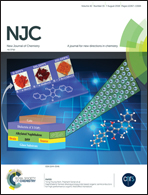Detection of gaseous amines with a fluorescent film based on a perylene bisimide-functionalized copolymer†
Abstract
A fluorescent film sensor based on a perylene bisimide (PBI)-functionalized copolymer for the fast and selective detection of aniline vapor has been fabricated. In this work, the common H-aggregation of the PBI units was obviously hindered by using numerous hydroxy-ethyl side chains as a spatial scaffold. Sensing performance studies demonstrated that the fluorescence of the film was instantaneously quenched by ppb-level volatile amines with excellent reversibility and reproducibility. The response time for aniline vapor was found to be less than 1 s. The high surface area and porosity of the silica gel substrate and hydrogen bonding interactions may assist the high sensitivity and fast response of the film towards aniline. Furthermore, the massive amount of fluorescence intensity data of the sensing film when exposed to low concentrations and a continuous flow of amine vapors were collected in a home-made sensing platform. In addition, the response feature investigates using the kinetic sorption and desorption information shows the promising potential of the film in real applications. This work has expanded the applications of PBI-based materials in the fluorescent sensing of toxic compounds, particularly amine vapors.



 Please wait while we load your content...
Please wait while we load your content...